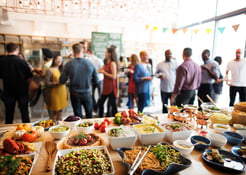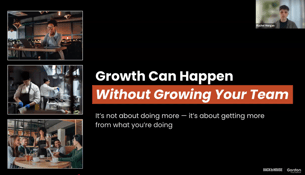It’s safe to say everyone — and we do mean everyone — enjoys free stuff. And we’re pretty sure most people prefer when that free stuff is food. So it’s no wonder restaurant loyalty programs are an effective way to bring new customers into to your restaurant and drive repeat sales. Many restaurant chains say loyalty programs bring in millions of dollars of additional sales per year, which in turns makes loyal customers of the restaurants themselves.
So let's start with the seemingly obvious question: What is a customer loyalty program anyway? In one sense, it's whatever you want it to be. Maybe you've got a punchcard system, in which 10 coffees gets a customer an 11th for free. Or maybe you have a chalkboard above the bar where regulars can buy a pint for their friends in absentia. These days, the rewards are likely to be tracked on an app or via your POS.
Those examples point to a decent unifying theory. A loyalty program is a way to entice your customers to come back in the future — to choose your establishment over sitting at home, or over your competitor down the block. In that regard, it's a style of marketing that your customers might not even realize is marketing. Which, when you think of it, is the best sort of marketing there is.
The program that's best for you will depend on your identity as a business, and the relationship you want to have with your customers. So let's figure out how to pick the right now, to keep your customers regularly walking back through your door.
How to set up a customer loyalty program
There’s no one-size-fits-all for loyalty programs. This is an arrangement between you, your customers, and the cool stuff they get when they decide to keep popping by your place. The easiest way to get started is to check with your POS system, which these days almost certainly has a way to track customers and implement a loyalty program. Of course, simply having the program doesn't mean it's going to be exciting or successful. That's where your creativity is crucial.
So get to know your customers even better. What do they order? Are they younger, on dates, in groups, more or less monied? And when do they show up, or not show up? All of these will inform how you want to entice their behaviors (if perhaps slower days are ideal for encouraging more traffic). You can eyeball it at this stage, or you can take advantage of some deeper-dive data analysis right out of the gate. Either way, you'll get to tweak as you go.
Make a plan, and make it simple. You know what people like? The stuff they order. You know what they don't like? Stuff they never order and don't want to. Are you known for a certain type of pizza? Got a new beer that launches every month? The formula is simple: the more enticing you make your rewards, the more the customers will want 'em.
Once you know what to offer, make it easy for your customers to redeem. Like, insanely easy. Because ain’t no one got time for a complicated loyalty program.
Many restaurants opt for digital programs to make it seamless for them and for the customer to track purchases and without a physical card. Digital programs also enable restaurants to glean deeper insights about their customers from the data, and adjust accordingly.
Be sure to train your staff. Your employees need to be well-versed in your program. They've got to explain it to customers, after all, coaxing them to sign up and letting them know what their existing purchases could get them if they join. As in, "you could have scored a free drink with your purchase today as a member of our loyalty program."
Staffers also have to integrate the loyalty program into the POS system. Snags at any point in the process are killers, including when people in line watch the person in front of them take more than 60 seconds to sign up for the program or redeem a reward.
>>>RELATED: Restaurant POS Systems: Things Every New Restaurateur Should Know
What should your loyalty program rewards be?
Time to experiment! Test which promotions and incentives hit best with your customers, at the price point that works for you. Here are some of the best in the game to get you thinking.
Starbucks: The coffee giant keeps it simple and convenient. Through an app, members customize their rewards. For instance, after accumulating a certain amount of points, rewards can be an extra espresso, specialty drinks, merchandise, you name it. Starbucks keeps things fresh by rotating in specials, double points days, and birthday freebies for members.
Chipotle: The burrito behemoth has leveraged its loyalty program to entice people to order from its app, helping to make online orders almost 50% of its sales. Chipotle Rewards offers 10 points for each dollar spent. At 1,250 points — and that comes quicker than you think (guac is extra!) — they score a free entree. The rewards program also includes a slew of spontaneous promos, such as exclusive access to new menu items and free add-ons. Even guac.
You may not have thousands of locations, but that won't stop you from inventing your own dynamite loyalty program. Smaller-scale locations have tons of room to get creative. At its 13 locations between North Carolina and Texas, the Flying Saucer offers a UFO Membership that permanently displays in a "Ring of Honor" the names of customers (aka “Beerknurds”) who drink 200 different beers. Now that’s loyalty.
How to promote your restaurant loyalty program
You know when people compliment your shoes, and you respond with, “thanks, I got them on sale"? Make that sense of cheerful deal-seeking the backbone for marketing your loyalty program and instilling a touch of FOMO (fear of missing out) with your customers.
Make sure your loyalty program is front and center on your website and a snap to join. Use your social media channels and email to get the word out on those rewards. Take good photos. Shoot snappy videos. Let everyone see what a group of friends can eat and drink with friends when they hit the points mark.
>>>RELATED: 6 Social Media Tools Every Restaurant Operator Should Use
Speaking of friends: build in a referral program, while you're at it, to reward people who refer others to the loyalty program. Offer points or a menu item, whatever works. Keep people spreading the good word on your behalf.
Your ultimate goal? To make your loyalty program appear so appetizing it would just be plain silly not to enroll.
[Photo by Andrea Piacquadio from Pexels]





